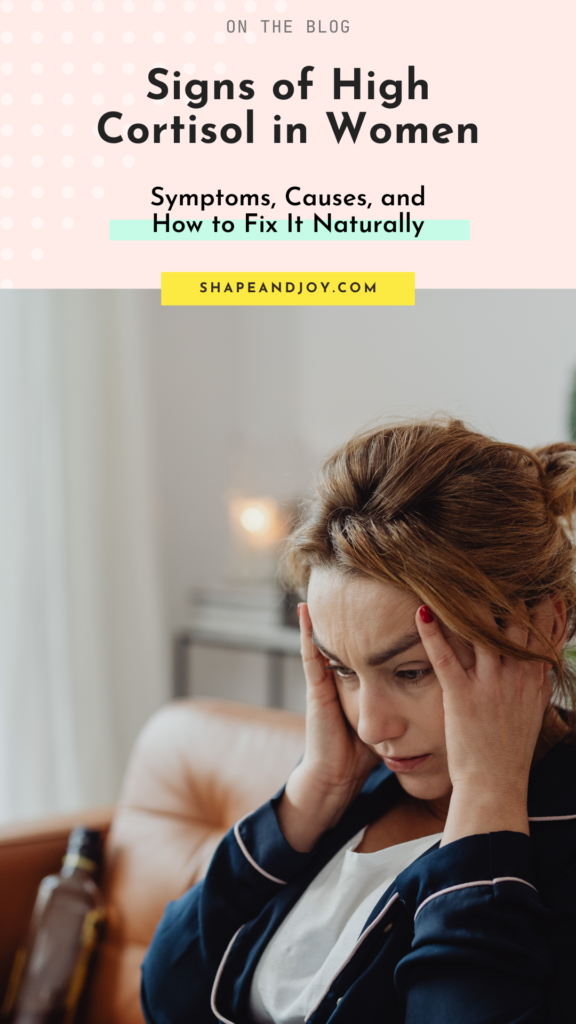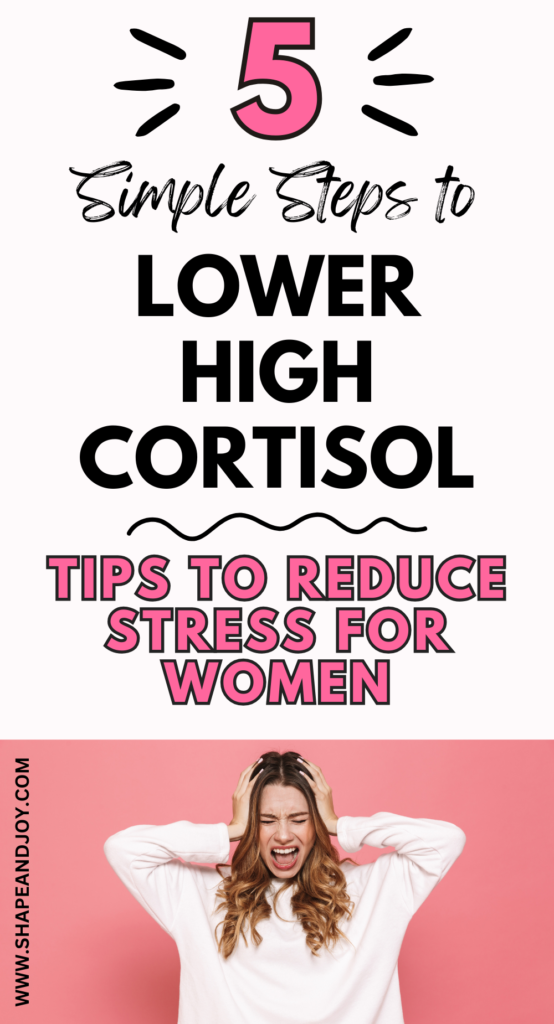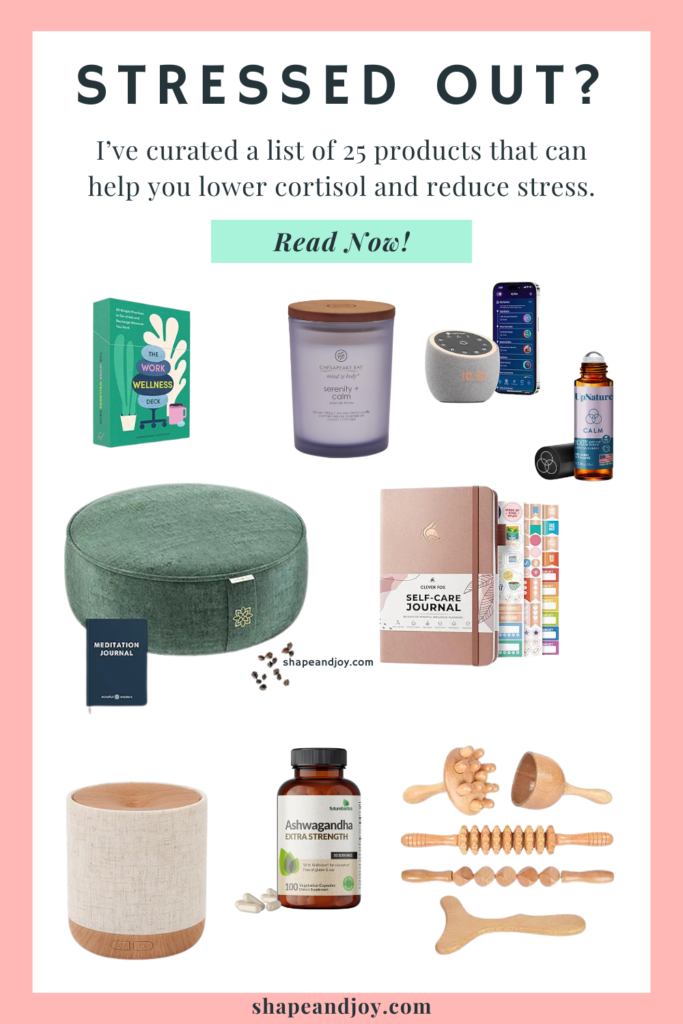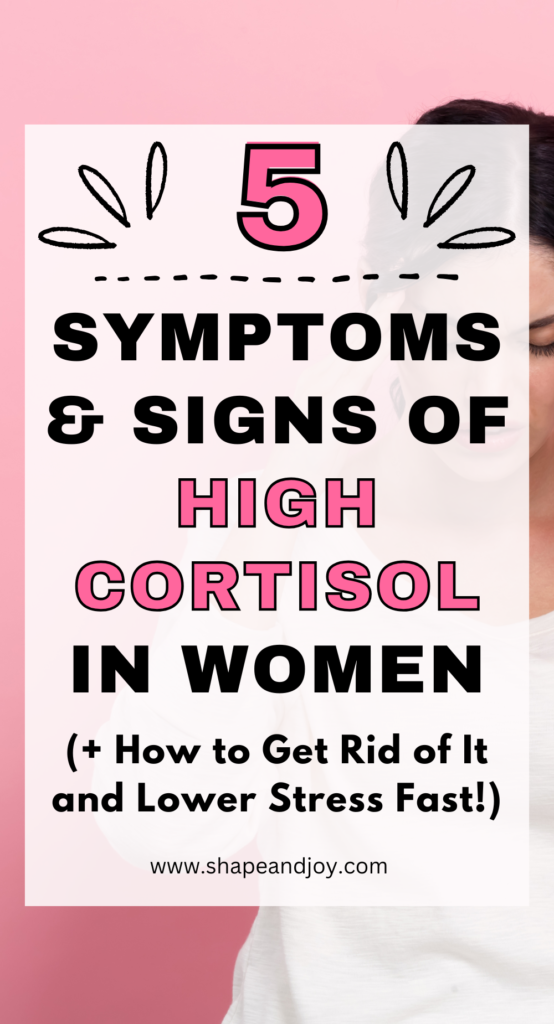This post may contain affiliate links, which means that I may earn a commission if you click on the link, with no cost for you. It’s one of the ways I support my blog. You can read more about this here.
Let’s face it, life can be stressful, and it’s no surprise that high cortisol in women is a common issue these days.
From stubborn belly bloat to sleepless nights, this stress hormone can wreak havoc on your body and mind if left unchecked.
But don’t worry, we’re about to tackle it head-on.
Together, we’ll learn how to reduce cortisol levels, understand the symptoms, and nail down a routine that works.
So, if you’re fed up with feeling frazzled, exhausted, or just not yourself, grab a cuppa, and let’s get to work!

Signs and Symptoms of High Cortisol in Women
Here’s the lowdown on what high cortisol can look like:
- Belly bloat and weight gain: High cortisol loves to store fat around your midsection. It’s like an unwanted guest who just won’t leave. For more tips on how to get rid of stress belly and feel more like yourself again, check out my post Get Rid of Stress Belly: Practical Tips!
- Sleep issues: Struggling to drift off or waking up at silly o’clock? That’s a classic sign.
- Mood swings and anxiety: One minute, you’re calm; the next, you’re ready to scream into a pillow.
- Cravings galore: Suddenly, all you want is sugary treats or salty snacks.
- Hair thinning and nail issues: Stress prioritises survival, not beauty, sadly.
If any of this sounds familiar, it’s time to learn how to get cortisol levels down and feel more like you again.


What Causes High Cortisol in Women?
Stress doesn’t just appear out of nowhere. Here are some sneaky culprits behind your cortisol imbalance:
- Chronic stress: Whether it’s deadlines, family drama, or just the daily grind, long-term stress keeps those cortisol levels spiking.
- Overdoing workouts: Yep, smashing out too many intense sessions can do more harm than good. You might need to switch to cortisol-lowering workouts.
- Sleep deprivation: Burning the candle at both ends? It’s time to rethink your routine.
- Diet troubles: Too much caffeine, sugar, or processed foods can worsen the problem.
- Underlying health conditions: Hormonal issues like PCOS or depression might also be at play.
How to Reduce High Cortisol Levels Naturally
Here comes the good bit: fixing cortisol imbalance. Here’s your toolkit of tips to lower cortisol:
1. Adjust Your Diet with Cortisol Foods
The right food can work wonders for reducing cortisol levels. Here’s the menu:
- Include cortisol foods like salmon, spinach, and sweet potatoes.
- Sip on herbal teas instead of caffeine-heavy coffee.
- Add a vegan smoothie option with magnesium-rich bananas and spinach for a quick cortisol fix.
Pro tip: Dark chocolate (in moderation) is brilliant for helping lower cortisol naturally. You’re welcome.
Want to make eating less stressful? Check out Mindful Eating 101 for tips on staying in a calorie deficit with ease.

2. Get Stuck Into a Cortisol Regulation Routine
Routines aren’t boring—they’re brilliant. A steady schedule helps your body know when to chill out. Try these steps:
- Stick to regular meal times with balanced cortisol foods.
- Build in some “me time,” like journaling or deep breathing.
- Aim for consistent sleep—yes, that means early nights (no scrolling in bed!).


3. Workouts for High Cortisol
Not all exercise is created equal when it comes to stress. The goal is to lower cortisol levels, not spike them. Here’s what to do:
- Switch out hardcore HIIT sessions for cortisol-lowering workouts like yoga, Pilates, or swimming.
- Go for a walk—bonus points if it’s in nature.
- Build strength with moderate weightlifting.
Cheeky Tip: Avoid overdoing it—sometimes less is more when it comes to workouts.

4. Find Ways to Lower Cortisol Naturally
The key to reducing cortisol levels is finding what works for you. Try this:
- Breathe deeply (yes, it works!).
- Try mindfulness apps or journaling to get rid of cortisol.
- Laugh more—yes, a good giggle actually lowers stress hormones.
Self-care is key to managing stress. Try these 5 simple activities to reset your life and feel your best.
5. Supplement Smartly
When diet and routines aren’t enough, adaptogens and supplements can help fix cortisol imbalance. Look for:
- Ashwagandha or rhodiola.
- Magnesium for relaxation.
- Vitamin D to boost mood and reduce cortisol.

The Risks of Ignoring High Cortisol in Women
Here’s the deal: leaving high cortisol unchecked can lead to bigger issues, from burnout to chronic health problems.
The effects?
Weight gain, hormonal chaos, and a never-ending cycle of stress. Learning how to reduce high cortisol levels now can save you from those long-term consequences.
How to Reduce High Cortisol Levels for Good!
If stress has been running the show—messing with your energy, cravings, and waistline—it’s time to take back control. This series is all about lowering cortisol naturally, stopping stress-driven weight gain, and helping you feel like yourself again.
Explore the full series:
- Cortisol Diet 101: The Best Foods to Reduce Stress Hormones – The ultimate guide to eating for lower cortisol and better health.
- Signs of High Cortisol in Women: Symptoms, Causes & How to Fix It (You’re here!) – Spot the warning signs and learn how to restore balance.
- 25 Amazon Products to Lower Cortisol & Reduce Stress Naturally – Easy lifestyle upgrades to help keep stress hormones in check.
- Cortisol Regulation Routine: Morning & Night Habits to Lower Stress – Daily habits to naturally reduce high cortisol levels.
- The Best Supplements to Lower Cortisol & Restore Balance – Science-backed vitamins and herbs to help fix cortisol levels.
- Cortisol & Emotional Eating: How to Stop Stress Cravings & Prevent Weight Gain – Focuses on how cortisol affects appetite and cravings, making it harder to stop snacking and leading to weight gain. Learn how to manage stress eating and regain control of your hunger.
- Get Rid of Stress Belly: Science-Backed Ways to Reduce Cortisol & Burn Belly Fat – Explores why cortisol leads to belly fat storage, even if you’re eating well. Learn how to target stress belly with cortisol-balancing foods, exercise, and lifestyle shifts.
Final Tips to Lower Cortisol and Feel Amazing
Let’s simplify things:
- Nourish your body with cortisol foods.
- Stick to a cortisol regulation routine.
- Focus on cortisol-lowering workouts to keep your body and mind in sync.
- Prioritise rest, relaxation, and laughter—it’s the best medicine.
By taking small, consistent steps, you’ll be well on your way to getting those cortisol levels in check. You’ve got this!
Stress less with a growth mindset! Learn how in this post on motivation and self-improvement.


Studies
Depressive symptoms in women are linked to elevated cortisol levels, which mediate issues like weight gain and metabolic risks (Muhtz et al., 2009).
Women with higher cortisol responses to stress show greater anxiety and mood instability, highlighting sex-specific effects of cortisol on stress perception (Smeets et al., 2009).
Overexertion in workouts can elevate cortisol levels, contributing to hormonal imbalances and fatigue (Gur et al., 2004).
Chronic stress and its effects on cortisol can lead to altered sleep patterns, increased abdominal fat, and impaired memory retrieval in women (Kuhlmann & Wolf, 2005).
Elevated morning cortisol levels have been tied to workload stress and metabolic dysfunction, showing the relationship between lifestyle factors and cortisol regulation (Lundberg & Hellström, 2002).
The menstrual cycle significantly influences cortisol levels, with changes in hormonal profiles affecting stress resilience and mood stability (Hamidovic et al., 2020).
Adaptogens and supplements like ashwagandha have shown effectiveness in modulating cortisol and improving stress responses (Christiansen et al., 2007).

